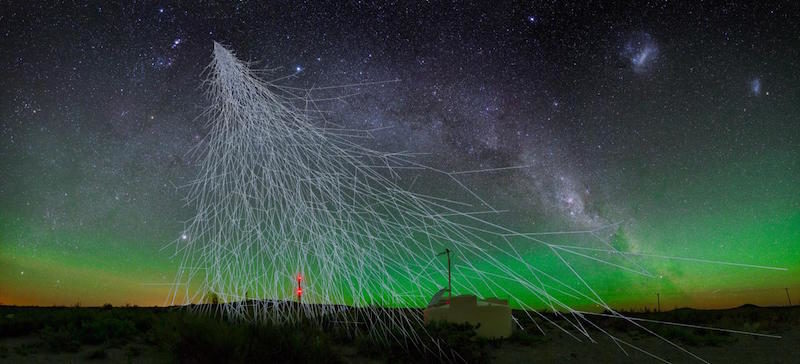
© A. Chantelauze, S. Staffi, L. Bret
Fifty years ago, scientists discovered that the Earth is occasionally hit by cosmic rays of enormous energies. Since then, they have argued about the source of those ultra-high energy cosmic rays - whether they came from our galaxy or outside the Milky Way.
The answer is a galaxy or galaxies far, far away, according to a report published Sept. 22 in
Science by the Pierre Auger Collaboration. The internationally run observatory in Argentina, co-founded by the late University of Chicago Nobel laureate James Cronin, has been collecting data on such cosmic rays for a more than a decade.
The collaboration found that the rate of such cosmic particles, whose energies are a million times greater than that of the protons accelerated in the Large Hadron Collider, is about six percent greater from one side of the sky than the other, in a direction where the distribution of galaxies is relatively high.
"We are now considerably closer to solving the mystery of where and how these extraordinary particles are created - a question of great interest to astrophysicists," said University of Wuppertal Prof. Karl-Heinz Kampert, spokesperson for the Auger Collaboration, which involves more than 400 scientists from 18 countries. "Our observation provides compelling evidence that the sites of acceleration are outside the Milky Way."
Cosmic rays are the nuclei of elements from hydrogen to iron. The highest-energy cosmic rays, those of interest in this study, only strike about once per square kilometer per year - equivalent to hitting the area of a soccer field about once per century.
Such rare particles are detectable because they create showers of secondary particles - including electrons, photons and muons-as they interact with the nuclei in the atmosphere. These cosmic ray showers spread out, sweeping through the atmosphere at the speed of light in a disc-like structure, like a dinner plate but several kilometers in diameter.
At the Auger Observatory, the shower particles are detected through the light they produce in several of 1,600 detectors, spread over 3,000 square kilometers of western Argentina - an area comparable to that of Rhode Island - and each containing 12 tons of water. Tracking these arrivals tells scientists the direction from which the cosmic rays came.After racking up detections of more than 30,000 cosmic particles, the Auger Collaboration found one section of the sky was producing significantly more than its share. The probability of this happening by a random fluctuation is extremely small, the collaborators said: a chance of about two in ten million.
"This result unequivocally establishes that ultra-high energy cosmic rays are not just random wanderers of our nearby universe," said Paolo Privitera, UChicago professor in astronomy and astrophysics, who heads the U.S. groups participating in the project.
Privitera credited Cronin, who died last year, with the original vision for the Auger observatory back in 1992.
"The imprint detected in their arrival directions - a tantalizing evidence for extragalactic origin - required several years of observations with a detector working, in Jim Cronin's words, 'like a Swiss clock.' It was a tribute to Jim's vision to build an observatory and unveil the mystery of the origin of the most energetic particles in the universe," he said.
Even at these high energies, cosmic rays may be significantly deflected by magnetic fields in outer space; thus the excess found by the Auger Collaboration in a broad section of the sky cannot yet determine which extragalactic objects might be the specific sources, the authors said. The observatory is looking to examine even higher-energy cosmic rays - rarer, but less likely to be deflected - which may provide a clearer route to their sources. Work on this problem is targeted for the observatory's upgrade, scheduled to be completed in 2018.
Reader Comments
All asteroids and heavy nuclei originate from the plasma pinch we call Sol. It was once called Eden/Aten.
They admit that the detections made currently have been deflected, but once again magic up some magnetism when it is needed! They seem to forget the plasmasphere and the Plasma pinch skirt rotating across the the Solar system.
They speak of a Collider. The Earth/Adam has a few! They are the invisible Van Allen belts where ions are stored until dislodged. They are hunting the Snark!
The expulsion/loss of the Saturnian era developed the split human consciousness that underlies the 'sleep of Adam'.
"Detectors, spread over 3,000 square kilometres of western Argentina" ... so they take a figure of 3000
"After racking up detections of more than 30,000 cosmic particles" ... bingo!!!! . they have detected every particle for the last 10 years, not missed a single one
How did they achieve this magic feat?
"1,600 detectors ... each containing 12 tons of water" .... so allowing 1M depth, assume a surface area of 3x4 = 12 square meters per detector
CERN is operating around 13Tev (1 Tev = 10^12 ev) .. so 10^13ev
Ultra-high-energy cosmic ray (UHECR) is a cosmic ray particle with a kinetic energy greater than 10^18 eV
Extreme-energy cosmic ray (EECR) is an UHECR with energy exceeding 5×10^19 eV
EECRs are above the Greisen–Zatsepin–Kuzmin limit (GZK limit) ... the maximum energy of cosmic ray particles that have traveled long distances
The "Oh-My-God particle" - 3×10^20 eV ...an atomic nucleus with a kinetic energy of 48 joules, equivalent to a 142 g (5 oz) baseball travelling at about 26 m/s (94 km/h; 58 mph)... travelling at ~ 99.99999999999999999999951% of the speed of light
Of the 87 cosmic rays surpassing 57 EeV detected thus far by the Telescope Array, 27 percent come from 6 percent of the sky. The hotspot centers on the constellation Ursa Major.
[Link]